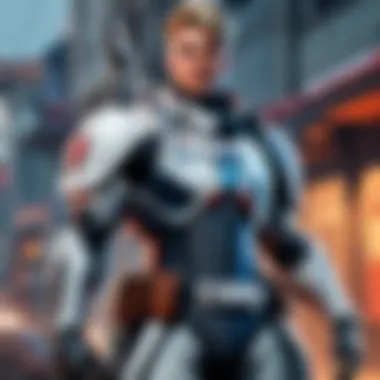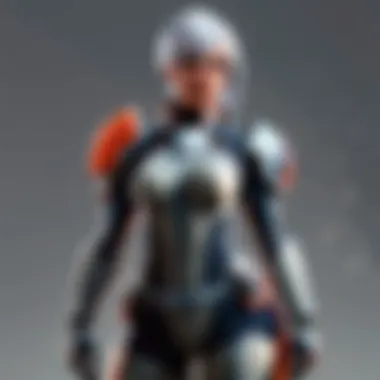Mastering Aim Precision in Valorant: Strategies & Techniques


Game Overview
Prelims to Valorant
To understand how to enhance aim precision in Valorant, it’s crucial to grasp the game's foundation. Valorant, developed by Riot Games, stands as a tactical first-person shooter that blends precise gunplay with unique character abilities. Each match demands not only mechanical skill but also strategic thinking, making it important for players to realize their aiming capability and how it connects to their overall game performance.
Game Mechanics and Objectives
Valorant's core gameplay mirrors that of classic tactical shooters while introducing agents, each possessing distinctive abilities that add layers to gameplay dynamics. Players engage in 5v5 matches where one team attacks and the other defends, showcasing a blend of coordinated teamwork and individual competence. Controlling a bomb site, planting or defusing the Spike, and outsmarting opponents form the heart of the game’s objectives. Mastering these elements is critical in honing aiming skills, as effective targeting can often make or break a round.
Brief History of the Game
Valorant made its debut in June 2020, capturing the attention of casual gamers and competitive players alike. Following an extensive closed beta, the game grew rapidly in popularity. With a combination of Overwatch-inspired heroes and Counter-Strike-inspired mechanics, it filled a niche within the gaming community, continually evolving over the years with updates, new agents, and seasonal content.
List of Playable Agents and Their Unique Abilities
Valorant features a diverse cast of agents, each equipped with abilities that enhance their playstyle. Understanding these agents is essential, because the chosen character can influence your aim strategy. Here’s a brief overview of some key agents:
- Sova: Excellent at gathering intel, with abilities that can pinpoint enemies’ locations.
- Jett: Known for agility, her abilities allow quick repositioning, which can complicate an enemy’s aim.
- Sage: A support character capable of healing and reviving teammates, thereby indirectly impacting engagement outcomes.
- Cypher: Focused on surveillance, his gadgets provide crucial information about opponent movements.
- Phoenix: A duel-wielder who can heal himself and cut through angles with fire abilities.
Understanding these agent abilities will enable players to appreciate how they can integrate aiming with their character's unique strengths during gameplay.
Understanding Aiming Fundamentals
To truly grasp the essence of achieving precision in aiming within Valorant, one must first understand the foundational elements that dictate success in this tactical game. Mastering aiming techniques goes beyond merely pointing and clicking; it encompasses a myriad of factors that, when harmonized, can dramatically enhance performance. In a competitive landscape, where every shot counts, knowing the basics empowers players to refine their skills and transform their gameplay.
The Importance of Aim in Tactical Games
Aim is arguably one of the most critical aspects of any first-person shooter. In tactical games like Valorant, players need to constantly make split-second decisions under pressure. This pressure testing often separates the novices from the veterans. Here are key points illustrating why aim is vital:
- Impact on Gameplay: Aiming directly influences kill potential and survival rates. A well-placed bullet can turn the tide of a match.
- Psychological Edge: Players with superior aim often intimidate their opponents, creating mental advantages.
- Game Mechanics Alignment: Understanding a game's specific mechanics, such as bullet drop and time-to-kill, helps in enhancing aiming strategy.
Focusing on aim not only improves individual skill but also strengthens team dynamics. Aiming precision fosters effective communication and teamwork, as teammates can rely on each other's shot accuracy during crucial play moments.
Overview of Aiming Mechanics
Aiming mechanics might sound simplistic at first, yet they are intricate and multifaceted. Within Valorant, several components intertwine to form the core of aiming:
- Crosshair Placement: Keeping your crosshair at head level and pre-aiming at common angles reduces reaction time and can lead to quicker eliminations.
- Movement and Shooting: Understanding the trade-off between mobility and accuracy is key. Moving while shooting can lead to inaccuracies; players need to find the sweet spot to remain agile while still being lethal.
- Recoil Control: Each weapon in Valorant has its own recoil pattern. Learning how to counteract this can significantly enhance shooting consistency.
"Understanding how your weapon functions is just as vital as knowing how to shoot it."
In essence, aiming mechanics serve as the building blocks for skillful play. Players armed with this knowledge can adapt their strategies in real-time, allowing them to capitalize on opportunities that may slip by less-informed gamers. The intricate dance of aiming mechanics is where strategy meets execution, and it's a realm worth diving deep into for any Valorant enthusiast.
Setting Up for Success
Setting up for success is often the unsung hero of gaming performance, particularly in a tactical shooter like Valorant. Just as a well-oiled machine needs the right components, skills in this game require a proper setup to flourish. The hardware you choose, the ergonomics of your playing environment, and your game settings can make a world of difference, elevating your aim from mediocre to exceptional. Let’s dive deep into these elements, as they lay the groundwork for improving your precision.
Hardware Considerations
Choosing the Right Mouse
Selecting the right mouse is paramount. It’s your primary tool in aiming and attacking, thus its design can greatly impact your performance. Players often gravitate toward gaming mice that have high DPI (dots per inch) settings and customizable buttons. For instance, the Logitech G502 is a popular choice among many for its ergonomic design and adjustable weights.
Key Characteristic: The responsiveness and comfort of a good gaming mouse allow for more accurate flick shots.
Why It Matters: A comfortable mouse makes long gaming sessions less of a chore, reducing fatigue. A mouse that fits well in your hand can facilitate better control during frantic matches, giving you an edge.
Unique Features: The DPI settings on a mouse like the Razer DeathAdder let you adjust sensitivity on the fly. This is particularly useful when switching between weapon types within a game, allowing for tailored control.
Pros and Cons: While a superior gaming mouse can enhance your aim, they often come at a higher cost. Be cautious of mouse choices that might look flashy but compromise on glide and function.
Importance of Mousepad Quality


A good mousepad might not strike you as essential, but it is. The right mousepad serves as the canvas for your movements, enabling smoother glides and precise stops. Many avid gamers favor large mousepads like the Corsair MM300 for their ample space and surface quality.
Key Characteristic: The material of the mousepad can affect how the mouse sensor interacts with the surface.
Why It Matters: A high-quality mousepad helps achieve consistent accuracy by providing a surface that works well with your mouse sensor.
Unique Features: Some gaming mousepads even come with built-in wrist support and RGB lighting, although these features are more about aesthetics than function.
Pros and Cons: A fraying or worn-out mousepad can lead to erratic movements. Conversely, while high-end mousepads might offer improved performance, the price can be daunting.
Monitoring Setup and Comfort
Your gaming setup should be more comfortable than a cloud. Positioning your monitor at eye level and using a chair that supports your back can prevent strain during long sessions. A comfortable gaming setup not only helps maintain focus but also keeps you in the game longer.
Key Characteristic: Ergonomic chairs and monitor stands help align your body properly in relation to your equipment.
Why It Matters: A well-aligned setup ensures that you're not straining your neck or back, allowing you to concentrate on your aim rather than discomfort.
Unique Features: Adjustable chairs that offer lumbar support can significantly improve your posture.
Pros and Cons: While investing in a good chair or stand can yield health benefits and better focus, it might require a considerable financial commitment upfront.
Game Settings Optimization
In order to truly harness your aiming potential, optimizing game settings is crucial. This entails fine-tuning sensitivity, customizing your crosshair, and choosing the right resolution, all of which can adapt Valorant to your personal preferences.
Sensitivity Settings
Finding the right sensitivity settings is a balancing act. Too low, and your movements might feel sluggish; too high, and your aim can go awry. Many players suggest starting with a sensitivity between 1.5 and 3.0, adjusting as necessary to achieve a natural feeling.
Key Characteristic: Correct sensitivity allows for precise aim while enabling swift reactions.
Why It Matters: Sensitivity directly influences your crosshair movements, making it essential to find a setting that feels right for you.
Unique Features: Some players prefer using a low sensitivity for pixel-perfect shots, while others opt for a higher sensitivity for quick taps across the battlefield.
Pros and Cons: Lower sensitivity can offer more accuracy, but it can make swift movements harder. Conversely, higher sensitivity allows for quicker reactions but risks inaccuracy in precision shots.
Crosshair Customization
A well-customized crosshair can improve visibility and focus. Many players opt to fine-tune their crosshair’s color, shape, and opacity. Creating a unique setup helps in spotting your target quickly.
Key Characteristic: A crosshair that contrasts well with the game environment can be beneficial in aiming.
Why It Matters: Visibility allows for quicker target acquisition, meaning the difference between hitting a shot or missing completely.
Unique Features: Valorant allows you to tailor crosshair thickness, length, and movement settings, offering versatility for different players’ styles.
Pros and Cons: While there's no one-size-fits-all crosshair, experimenting can take time. It may feel odd initially but finding the right one enriches gameplay.
Resolution for Performance
Your resolution settings can profoundly influence the game experience. Higher resolutions often lead to clearer images, while lower resolutions can ensure better frame rates in competitively intense situations.
Key Characteristic: Achieving a balance between clarity and performance is vital in a tactical shooter.
Why It Matters: If your game runs smoothly, your aiming will feel more connected to your reactions.
Unique Features: Some players might choose a stretched resolution to enlarge character models, enhancing their target sizes for easier hitting.
Pros and Cons: Striking a balance can be tricky; you'll want clarity while still ensuring a responsive frame rate during gameplay. Adjusting the resolution ultimately depends on your hardware capabilities and personal preferences.
Training Techniques for Better Aiming


When it comes to improving aim precision in Valorant, a structured approach through training techniques is essential. The significance of deliberate practice cannot be overstressed. These techniques are not merely optional extras; they form the backbone of skill enhancement. By honing your aim through various methods, you develop muscle memory and reflexes, both of which are crucial for prevailing in tense firefights. The world of FPS gaming demands not just fast reactions but also consistency, and that’s exactly what these techniques offer.
Aim Training Programs
Overview of Popular Tools
Familiarizing oneself with aim training programs is like putting on a pair of glasses for the first time; suddenly, the world seems clearer. Tools like Aim Lab and Kovaak's FPS Aim Trainer are leaders in this space. These programs provide a controlled environment where players can focus on various aiming skills like flick shots, tracking, and precision targeting. What sets Aim Lab apart is its diverse set of training scenarios tailored to specific skills, making it a top choice for anyone serious about honing their aim. While Kovaak’s might boast a slightly steeper learning curve, its degree of customization allows players to mold their training to fit their personal weaknesses, which is incredibly advantageous.
Benefits of Structured Drills
Structured drills encapsulate the essence of training. They give players a chance to engage with a specific aspect of aiming methodically. Unlike random practice, having a well-defined routine leads to better skill acquisition. For instance, performing drills that emphasize shooting at small moving targets helps build precision, while engaging in exercises that require constant movement can improve reflexive responses. This structured approach provides clear milestones; thus, players can discern improvements over time, which keeps motivation high. However, it's important to integrate these drills without allowing them to become monotonous—variety is the spice of life, after all.
Integrating Aim Trainers with Play
Integrating aim trainers into regular gameplay enriches the learning experience. It’s not just about spending time in a training program; rather, the magic happens when players take those refined skills and apply them in the heat of battle. The key is making it a habit—spend a few minutes each session in an aim trainer before diving into Valorant matches. This transition helps in solidifying skills and makes players feel more comfortable in actual games. One disadvantage, though, is that it can be challenging to find balance; overdoing training can lead to fatigue, which hampers performance. Finding that sweet spot is crucial.
In-Game Practices
Custom Games with Bots
Custom games with bots serve as a practical way to learn and practice without the pressure of competing against real opponents. This setting allows players to focus on specific aiming techniques, like headshots or tracking moving targets at various distances. The beauty of this method lies in its versatility; you can adjust bot difficulty to match your skill level, providing a tailored environment for improvement. That said, it's also vital to remember that bots often lack the unpredictability of human players, meaning that while this practice is valuable, it shouldn’t replace real encounters entirely.
Deathmatch Strategies
Engaging in Deathmatch modes is perhaps the closest experience to actual competitive play without the pressure of ranked matches. The intense, no-holds-barred action of Deathmatch helps players to sharpen their reflexes and decision-making under stress. Players can experiment with weapon choices, movement techniques, and map traversal all while focusing strictly on their aiming skills. However, it’s crucial to enter these games with a clear objective, otherwise, it could become chaotic and unproductive.
Utilizing Aim Labs and Similar Modes
Aim Labs and similar modes provide specialized scenarios designed to enhance aiming skills. These tools often come packed with analytics that can help players fine-tune their performance and identify weaknesses. For example, tracking scenarios can emphasize the importance of fluid movements, while flick shots focus on improving reaction times. On the downside, spending too much time in dedicated scenarios can sometimes deprive players of needed instinctual responses that come from actual gameplay. A balance between practice in aim trainers and real matches is necessary.
Remember, every expert was once a beginner. Monitoring progress and adapting techniques will ensure you continue moving forward in your skills.
Psychological Factors in Aiming
In the world of competitive gaming, the act of aiming transcends the mere mechanical responses; it is deeply entwined with psychological elements that can dictate overall performance. Understanding these psychological factors is not just an afterthought but a crucial part of sharpening one’s aim in Valorant. As players throw themselves into the heat of the battle, mental clarity, focus, and reaction time can greatly impact the outcome of any match. Armed with the right mindset, a gamer can enhance their precision while navigating the complexities of team dynamics and unpredictable enemy movements.
Understanding Reaction Times
Reaction time is a fundamental element influencing how effectively players can respond to in-game stimuli. When a flicker of movement catches the eye, milliseconds count. This aspect of psychology is both a skill that can be honed and a trait that varies among individuals. To improve reaction time, players can leverage tools like online reaction time tests or drills that require rapid responses to visual cues.
Moreover, understanding one’s own reaction capabilities can lead to better strategic decisions in gameplay. For example, a player who knows they have slower reaction times might favor close-range engagements where enemy movements can be predicted more easily. Conversely, a player with quick reflexes may thrive in long-range precision challenges.
Maintaining Focus During Matches
Strategies for Mental Clarity
One of the hallmarks of sustained success in aiming is mental clarity. This involves clearing the mind of distractions and focusing solely on the task at hand. Effective strategies for achieving mental clarity include:
- Breathing Techniques: Practicing deep and synchronized breathing can indeed calm nerves before or during a match, fostering a more stable mental state.
- Visual Focus: Players can train their eyes to concentrate on specific targets within the game, thus minimizing distractions from the surrounding chaos.
- Mindfulness Exercises: Engaging in mindfulness techniques can help in developing a heightened awareness of the game environment and one’s own actions, leading to more deliberate aiming.
By implementing these practices, players can create a conducive mental environment that sharpens aim and enhances performance in various scenarios.
Handling Pressure Situations
The ability to perform under pressure is another psychological aspect that can greatly influence aiming precision. High-stress situations—such as clutch rounds or intense firefights—can cause even the most seasoned players to falter with their aim.
To tackle this, players should consider:
- Simulation of High-Stress Scenarios: Engage in custom games that mimic high-pressure situations. This could involve going against multiple bots or rival players where stakes feel high.
- Mental Visualization: Imagining themselves succeeding in high-pressure scenarios can condition the brain to respond effectively when the real moment arrives.
- Positive Self-Talk: Cultivating an internal dialogue that encourages rather than criticizes can bolster confidence when under fire.
Handling pressure efficiently can be the difference between a crisp headshot and a missed opportunity, making it critical for anyone looking to sharpen their aiming skills in Valorant.
"It’s not about the gun, it’s about the player behind it and the mind that guides their aim."
By focusing on these psychological factors, players can pave a structured path toward enhancing their aim precision. Maintaining mental clarity, understanding one's reaction capabilities, and mastering the art of performing under pressure become not only essential skills but also integral components of a comprehensive approach to improvement.
Analyzing Gameplay Performance
When it comes to improving one's aim in Valorant, it’s all well and good to practice diligently, but no real progress can be made without a careful look at how one performs in matches. Analyzing gameplay performance provides invaluable insights that can help players figure out what’s working and what needs a bit of fine-tuning. By scrutinizing match statistics, recognizing personal weaknesses, and seeking external feedback, players can identify precise areas for improvement and lay a clear path toward advancing their skills.


Reviewing Match Statistics
Identifying Patterns in Gameplay
The key advantage of identifying patterns in gameplay is that it allows players to recognize recurring behaviors and choices in their play style. The way one performs can fluctuate from round to round, often revealing underlying tendencies. For example, if a player consistently struggles to hit shots during clutch moments, it indicates a potential problem in high-pressure situations. This pattern is essential; it shines a light on habits that may not be obvious during the heat of battle.
Data analytics tools can assist players in tracking their performance closely. They provide a breakdown of shooting accuracy, kill-death ratios, and even the type of engagements that yield the best results. Players can delve deeper into aspects like whether they tend to engage enemies at long-range more effectively than up-close. This kind of understanding can redefine one’s training focus.
The unique feature of this process is how it allows for a detached view of one’s skills. It’s not just about hit or miss; it’s a comprehensive analysis that helps identify emotional factors too, such as how tilt might be impacting one’s performance. Understanding these layers can greatly assist in counteracting tendencies that hinder progress.
Recognizing Weaknesses in Aiming
Recognizing weaknesses in aiming is both critical and challenging. Players often don’t realize the specific moments when their shots go astray. A common weakness might be the inability to track a fast-moving enemy or perhaps overcompensating for recoil. This self-awareness is crucial for growth.
Having a routine for checking past performances allows players to pinpoint where their aiming falters most frequently. For instance, examining whether they struggle against specific weapon types can sharpen focus and enhance aim accuracy over time.
In the arena of competitive play, relying on statistics highlights the necessity of being exceedingly self-critical. The drawback here is that it might lead to frustration if the issues are not addressed. But recognizing weaknesses provides actionable information: if a player knows they need to improve tracking, they can dedicate their practice hours to that specific skill set.
Seeking Feedback From Others
Importance of Peer Reviews
Gaining insights from peers can be a powerful driver for improvement. Peer reviews offer an external perspective, shedding light on aspects of performance that might otherwise go unnoticed. A player’s friend or teammate might notice habits that are detrimental or spot patterns in gameplay that stand out - even when the player is oblivious to them.
This mutual exchange of feedback fosters a culture of learning and growth within a team or group. It’s not simply about finding faults; it’s about enhancing collective knowledge about effective aiming techniques. The characteristic of peer reviews lies in their collaborative nature. Sharing experiences and advice among players can unveil novel strategies that one might not have considered solo.
Moreover, suggesting specific drills or adjustments can keep one from falling into a rut. Yet, a challenge exists here; sometimes feedback isn’t constructive or might not resonate personally, making it vital to find trusted allies who can provide useful suggestions.
Using Coaching Resources
Utilizing coaching resources can elevate a player’s game to new heights. Whether working with a professional coach or using online resources, these tools can fill in knowledge gaps that might hinder a player from breaking through their current skill ceiling. The standout feature of coaching resources is their structured approach; they can create comprehensive training plans focusing on a player’s unique needs.
Coaching can involve anything from personalized drills to analysis of specific gunplay. Some may opt for online videos or forums, while others could look at tailored training sessions with experts. Each offers advantages and ensures that players are not merely practicing aim aimlessly but doing so with direction.
That said, it’s essential to pinpoint the right coaching resource. Some programs may not align with a player’s style or skill level, leading to frustration. Therefore, conducting thorough research to find the best fit is crucial.
In summation, evaluating gameplay performance, identifying patterns, and seeking feedback from others play indispensable roles in refining aiming skills in Valorant. With dedication and careful analysis, players can carve a tailored path to improving game precision, setting themselves up to triumph in each match.
Implementing Continuous Improvement
The journey to mastering aim precision in Valorant involves not just strategies and practice but also a commitment to ongoing development. Implementing continuous improvement serves as a crucial pillar in this overall aim enhancement process. It encourages players to perpetually refine skills and adapt to an ever-changing game environment. Aiming in Valorant isn't something you perfect overnight; it's a gradual evolution. By continuously assessing techniques and adapting to updates in the game, players can maintain a competitive edge.
Among the specific elements to consider are the establishment of measurable personal goals, adapting tactics in response to gameplay changes, and reviewing performance diligently. Each facet of this continuous improvement cycle promotes growth and resilience. Whether you're trying to crank up your headshot percentage or simply become more consistent in clutch moments, the effort you put into self-evaluation and adjustment can be the differentiating factor between a mediocre player and a top-tier competitor.
Setting Personal Goals
Creating Measurable Objectives
Creating measurable objectives serves as the concrete foundation for enhancing aim precision in Valorant. By breaking down larger goals into smaller, quantifiable milestones, players can track their progress and gauge their improvement effectively. A key characteristic of these measurable objectives is their specificity; for instance, aiming to increase headshot accuracy from 30% to 40% over a month gives you a clear target. This clarity fosters motivation as you see tangible results from your efforts.
Another unique feature of these objectives lies in their adaptability. For those just starting, a goal might revolve around familiarizing oneself with different firearms. In contrast, a more experienced player might focus on mastering certain maps or angles. The advantages are manifold—these goals help delineate a structured path for skill enhancement, reducing the overwhelming nature of the overall journey.
Tracking Progress Over Time
Tracking progress over time is indispensable in the quest to enhance aiming skills. This process involves documenting performance metrics such as accuracy rates, response times, and even match outcomes. The key characteristic here is the ability to revisit historical data and identify trends in performance. For a player striving for improvement, understanding where one has come from is pivotal for knowing where to go next.
One particular advantage of monitoring progress is it enables players to spot weaknesses in their skills promptly. For instance, if a player notices a dip in accuracy during high-stakes matches, that insight can lead to focused training sessions aimed at tackling pressure situations. However, it’s worth mentioning that the process of tracking must be consistent for meaningful insights, leading to regular reflections and adjustments.
Adapting to Game Changes
Staying Updated on Game Mechanics
Staying updated on game mechanics is vital for maintaining a competitive edge in Valorant. Riot Games frequently rolls out patches and updates that can alter weapon balance or change the dynamics of maps. A significant aspect of remaining informed is that it helps players recognize how adjustments affect their gameplay strategies. Understanding these nuances enables players to modify their approaches accordingly.
The key benefit of being up-to-date with game mechanics is preparedness. Players that are aware of changes can anticipate shifts in gameplay, allowing them to adapt more quickly than those who are uninformed. Nevertheless, it’s important to balance this focus with actual practice—overloading oneself with information without applying it can lead to confusion and stagnation in skill development.
Adjusting Strategies Accordingly
Adjusting strategies accordingly is another key dimension of continuous improvement. As players learn more about the game’s evolving landscape, they must be open to shifting their approaches. This might mean altering playstyles, repositioning in response to enemy tactics, or adapting to new meta weapons. The key characteristic of efficient strategy adjustment is the ability to evaluate the effectiveness of your tactics swiftly and make changes as necessary.
A unique feature of this adjustment process is its inherently dynamic nature. Players need to be flexible and responsive—a rigid mindset can lead to missed opportunities. On the flip side, it can be daunting to constantly reassess strategies. The risk of feeling overwhelmed when frequently aligning tactics with game changes is very real. However, the advantage lies in greater competitiveness and adaptability in matches, which can ultimately improve overall performance in Valorant.



